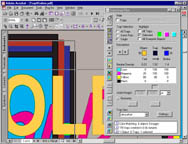Printready - the JDF work flow designed for the print room
Since it started shipping in June this year, the Heidelberg Prinect Printready System is transforming the industry’s concept of digital workflow effectiveness. The Printready System, part of the Prinect concept, is the most recent development in the Heidelberg vision of multiple modules working together to optimise workflow in the printing plant.
 According to Colin McKenzie, Product Manager CTP and Workflow (pictured), Printready is a complete system that transcends the barriers between different parts of the production process. “Unlike other recently released workflows, Printready is not just a prepress product, but a total workflow system designed specifically for the print room.
According to Colin McKenzie, Product Manager CTP and Workflow (pictured), Printready is a complete system that transcends the barriers between different parts of the production process. “Unlike other recently released workflows, Printready is not just a prepress product, but a total workflow system designed specifically for the print room.
CTP and workflow have a common goal – preparation of plates for the press. The pressroom is the major profit centre, so providing printing plates that are prepared correct and consistent from job to job is a major benefit. This is where Printready excels," he said.
This view is reinforced by Dr. Peter Leu, Head of Product Management Prinect who says the Printready System is an important step towards integrating all processes from prepress to press and finishing in order to make the overall procedure more productive and cost-effective. “The new solution is fully modular, in line with the basic principle of Prinect, so that customers can select individual components and add them to the overall system depending on their specific requirements. The Prinect Printready System provides the opportunity to map and automate all the prepress tasks in a freely configurable, digital workflow.”
Designed for Printers from the ground up
The Printready System has been designed by Heidelberg for use by printers – its use of JDF as an internal format being one of main distinctive features. JDF, (Job Definition Format) has the promise to automate the entire print production, from order entry and administration through to logistics. Heidelberg, being the only manufacturer of equipment used in all parts of the printing processes, is able to conduct all necessary R&D and testing in-house, rather than hoping it will work during beta testing.
JDF can describe almost any part of a print job, from the type of fonts required, through to paper weight, and folding scheme. This description cannot only do presetting of the press and the finishing process, but can also deliver an audit of what happened. This enables companies to determine their profitability by job or profit centre with higher degrees of accuracy.
How easy is it?
Printready is easy to set up and use. Training time compared to previous PDF based workflow requires is working out at around half as long. Adding further modules is also a breeze, The Component Self-Integrator (CoSI) automatically recognizes and integrates newly added modules into the system. The user unlocks the chosen add-on using a license key and thanks to CoSI-Technology the new functions instantly appears at every workstation with a Printready desktop. The workflow solution is scaleable at any time, since the combination of all its components together forms a communication unit.
Printready - a modular architecture
Printready works by distributing software components within client/server architecture. The Printready desktop controls and accesses all engine modules. Process steps for the job in hand are performed automatically according to customized workflow plans by the Printready engine. Preset templates for standard jobs are established by Heidelberg and the client upon installation. Subsequent modification can be performed at any time – tailor-made for every user.
Plug-ins for Acrobat and stand-alone applications are also available for interactive operation at the desktop.
Engine Modules
The Engine Modules consist of the MetaDimension software RIP, now JDF-compatible, plus other software components, such as the Normaliser, Preflighter and Archiver that automatically process the jobs using predefined parameters. MetaDimension is a variable interface to proofers, CtF and CtP.
The well-known Heidelberg trap engine is now used for the Printready Trapper. The same engine is used for the interactive Acrobat Plug-in Supertrap.
The Color Carver module is a new feature. Based on the Color Management from Heidelberg, it automatically ensures reliable colour processing ready for printing. These features are also available in an interactive version of the new Acrobat Plug-in Supercolor. The familiar SignaStation imposition software version 8.0 is also available in interactive form. PitStop Professional and Instant PDF from Enfocus are available as additional supplements.
Colour Management is a key component
Colour management can also be handled differently, depending on the job or customer’s workflow requirements. The automated engine module, named Color Carver, or a brand new Heidelberg Acrobat 6.x plug-in, SuperColor. Heidelberg's new Acrobat plug-in ensures colour fidelity in PDF documents. Supercolor extends the company's expertise and tools for colour management, using Heidelberg's "Color Matching Method" (CMM), which experts praise for its excellent colour management results. Supercolor is an Acrobat plug-in that can be used on both Mac and PC.
Supercolor is suitable for all users who need to process PDF documents with professional results and absolute colour fidelity for output in offset printing, digital printing and Web publishing as well as for CD ROM productions. Supercolor supports ISO standard PDF/X-3, the new PDF specification optimised for print output.
 Supercolor can eliminate the problems that can occur – particularly during printing – when using colours from the PDF colour spaces. Supercolor checks PDFs for all the colour spaces, ICC profiles and special colours used. This provides a reliable means of identifying potential sources of error quickly. Supercolor shows all colours and colour spaces used in the PDF and enables them to be processed individually:
Supercolor can eliminate the problems that can occur – particularly during printing – when using colours from the PDF colour spaces. Supercolor checks PDFs for all the colour spaces, ICC profiles and special colours used. This provides a reliable means of identifying potential sources of error quickly. Supercolor shows all colours and colour spaces used in the PDF and enables them to be processed individually:
Both Supercolor and Supertrap are available as trial demo versions via the Heidelberg web site, www.heidelberg.com
Integration with existing equipment
Printready can be integrated to an existing Heidelberg prepress installation quickly and easily. For example, there are dedicated modules available to output flat PDF files suitable for existing Delta Technology users.
Customers with Meta Dimension and Signastation can also easily add Printready to their workflow. Since both of these systems are now fully JDF compliant, they can be easily integrated - and then both become modules of the Printready system - receiving instructions as detailed in the JDF file.
Heidelberg's goal - one workflow for all - Printready forms an integral role in the Prinect workflow.
For further information please contact Colin Mckenzie ,Product Segment Manager – Prepress & Prinect, on 1300 656 949 or e-mail
colin.mckenzie@ap.heidelberg.com
 According to Colin McKenzie, Product Manager CTP and Workflow (pictured), Printready is a complete system that transcends the barriers between different parts of the production process. “Unlike other recently released workflows, Printready is not just a prepress product, but a total workflow system designed specifically for the print room.
According to Colin McKenzie, Product Manager CTP and Workflow (pictured), Printready is a complete system that transcends the barriers between different parts of the production process. “Unlike other recently released workflows, Printready is not just a prepress product, but a total workflow system designed specifically for the print room. Supercolor can eliminate the problems that can occur – particularly during printing – when using colours from the PDF colour spaces. Supercolor checks PDFs for all the colour spaces, ICC profiles and special colours used. This provides a reliable means of identifying potential sources of error quickly. Supercolor shows all colours and colour spaces used in the PDF and enables them to be processed individually:
Supercolor can eliminate the problems that can occur – particularly during printing – when using colours from the PDF colour spaces. Supercolor checks PDFs for all the colour spaces, ICC profiles and special colours used. This provides a reliable means of identifying potential sources of error quickly. Supercolor shows all colours and colour spaces used in the PDF and enables them to be processed individually: